by Lazar
Freidgeim
(click on photos to enlarge image)
HOW TO BECOME A MILLIONAIRE
Reasonings of the treasure hunter
It' s as easy as apple pie. Nothing can be easier… To hit
the jackpot or win a big hand in blackjack. To know every single
answer in a TV quiz show. To marry into wealth. To be born smart
and business minded in a proper time and place like Rockefeller
or Bill Gates. To invent or develop the next big thing. To pick
the right stock just before the news… The list goes on and on.
There are many fair ways to get rich. Not to mention the unfair
ones: to heist the bank, to blackmail a TV anchor, or simply
force somebody rich enough to shell out your nice share…
There is also another easy way as old as the world: buy cheap -
sell high. Since my school years I often have been thinking of "Adventures
of Mottel, the Cantor’s Son" by Sholom Aleichem and the desk
manual of always cheerful Elie, Mottel's brother. The book
titled "For One Ruble, One Hundred Rubles (how to earn one
hundred rubles with one ruble in a month)". Mottel learns about
every day life and lectures us: "My brother Elie never loses his
heart because we have burn one's fingers on kvass" [meaning that he is
not upset, as already there were unsuccessful attempts (to make kvass, a
Russian alcohol-free beverage)]. "If Elie only has his book,
everything is going to be OK. Elie bought that book for one
ruble. My brother has been pouring over the book and is learning it
by heart". The book contains an endless list of recipes for
making money. Elie already knows most of them. For example how
to make ink, boot polish, how to exterminate mice, roaches and
other filth.
I came to America with the background of a science lab manager.
However, I landed my first job in an antique jewelry business. My
boss considered himself lucky, when he bought something below
the reasonable price. He would then rub his hands with pleasure:
"What a deal! I couldn't have done better stealing it". He could
hardly wait until the seller would leave, to show it and say: "A
fine French Art Nouveau brooch I bought for the price of scrap
gold". The brooch shaped as a dragonfly and covered with
polychrome enamel. Immediately after the purchase he labeled the
fine piece many times more expensive and put it in a showcase
for sale. Unfortunately, going this route you might see some
problems - simply put, the success is far from guaranteed.
I am talking here however about a secure way. My recipe is
extremely simple and is based on several rules. All you need need
to do is just follow them one by one. Unfortunately it has been a long
time since I had to put my ideas in words as precisely as
needed for scientific articles. Please do not be a severe judge,
when it comes to shortcomings in my recommendations. For my
personal well-being I prefer the rule of having pleasure.
Therefore do not be surprised that every rule contains two parts
- the deed and its result. These are my rules in plain words:
- find something extraordinary and enjoy it;
- learn how interesting and rare it is and enjoy it even more;
- look at the acquired thing(s) every day and enjoy them again
and again;
- perceive the possibility of converting your collection into
cash and enjoy the mere idea of that (But not to sell it).
You certainly can go to the 5th Avenue and 42nd Street in New
York to find something worthy. You can visit the antique shops
on Arbat Promenade in Moscow, Russia, or on Rodeo Drive in Los
Angeles. You can become a frequent guest at Sotheby’s or
Christie's auctions. You have a good chance to buy something
valuable. If you are a millionaire, you will most likely lose
this title for a while because the purchase implies an
equivalent exchange of piles of money for what you buy. But you
would miss the ethereal feeling of joy because you would not
have done anything personally to find the rarity. My approach
however implies my active involvement in searching for the
interesting pieces which brings the feeling akin to that of a
hunter going after the rare game. Knowledge, intuition and good
luck often compensate for the lack of the thick wallet.
My advice won’t suit everyone. This reminds me of an old joke
popular in the former Soviet Union. The meaning of the joke is
hard to explain to people living in a country without shortage
of every day supplies like toilet paper (available now in every
supermarket). Anyway, a man is carrying rolls of toilet paper
assembled together like beads on a string and wrapped around his
neck. Another guy sees him on the street: "Where did you get
that?" "It's not for you", the happy owner answers, "I got it
at the cleaners".
Where should you search, where should you use the virtual
pickaxe and the shovel of a gold miner? You get a great chance
in small antique shops away from fashionable neighborhoods, at
swap meets, flea markets, or small estate sales, when an old
house is being sold. Do not miss Internet auctions so popular
nowadays - the offers and the prices are sometimes overwhelming.
Those collectors entirely free of snobbery would hardly forgive
themselves if they miss Salvation Army thrift shops or garage
sale widely available on the vast territory from Atlantic to
Pacific. What you need is love for "hunting" and minimal
experience like knowing the difference between Faberge and
Fragile, American "silver" and "sterling" or Russian silver, as
well as the difference between hundred year old "rubbish" and
mass production, a gawky painting and polychrome, temperature
sensitive, enamel requiring skill and patience.
In the good old times, when I lived in
Russia, I used every opportunity to search for
something interesting during my business trips far
from Moscow. There was that jewelry shop in Rostov
city where I bought an elegant gold brooch in the
shape of a bow. It was covered with enamel of navy
color, embellished with small diamonds, and a loop
was provided, so that the brooch could be worn as a
pendant as well. The overall style and especially
the facets on the diamonds indicated that the thing
was very old. I thought that the brooch could have
been a part of some Russian order. There was no
Internet back then, but I searched through the pile
of reference books and catalogs on Russian orders,
almost everything I could get my hands on in the
Soviet libraries. Alas, all was in vain - I could
not find a single clue. The puzzle was solved later
quite unexpectedly. While working in an antique
business in Los Angeles I came across a Swiss lady's
watch from the 1880s with exactly the same
brooch only in white color. This thing is rare and
expensive.
|
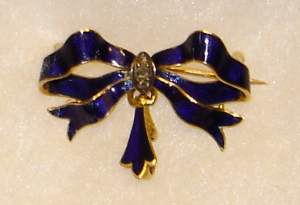 |
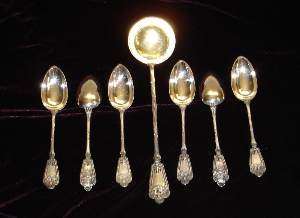
|
Several years later another purchase gave me
great pleasure. In the same store in Rostov I
bought a set of table silver for the price of 10
kopecks per gram (100 kopecks equaled 1 ruble). The
set had a soup ladle and six soup spoons weighing
altogether 800 grams. I paid a usual price for common
table silver. The spoons had immediately drawn my
attention by the perfect classical shapes popular
during the heyday of Art Nouveau in Russia. There
were depictions of chimeras on the spoon handles.
The chimeras had always been a special subject in
the jewelry art. My purchase resembled a Faberge set
that I had seen in Moscow for an enormous price some
time before. From Rostov I went to Grozny (Chechnya)
and there showed the set to a jeweler; an
acquaintance of mine. The jeweler examined every
piece, pointed out the crack between the handle and
the ladle, as well as the damaged gilt; and on top
of that the secondary mark over the original one,
the Soviet mark depicting "875" and a Red Army
soldier en profile. And he offered me $800;
ten times more than I had paid.
|
Later, in Los Angeles, I received another offer
to sell the set "as is" with all the defects for
four thousand dollars! The secret of the dazzling
outcome is simple - the spoons were designed by G.
Tcheryatov, one of the best Russian jewelers. The
mark on the spoons says
 (GTch in Latin), and there is inscription on the
soup ladle
(GTch in Latin), and there is inscription on the
soup ladle
 (G. Tcheryatov). The gold and silver factory of
Georgy Kuzmich Tcheryatov functioned in Russia from
1900 till 1917 and produced mostly small amounts of
silver dishes and table sets ordered by the Loriye (
(G. Tcheryatov). The gold and silver factory of
Georgy Kuzmich Tcheryatov functioned in Russia from
1900 till 1917 and produced mostly small amounts of
silver dishes and table sets ordered by the Loriye ( in Russian) Company. Works produced by Feodor Loriye
can be granted the same quality as that of Faberge
and are often priced very high.
in Russian) Company. Works produced by Feodor Loriye
can be granted the same quality as that of Faberge
and are often priced very high.
|
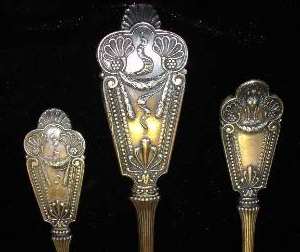 |
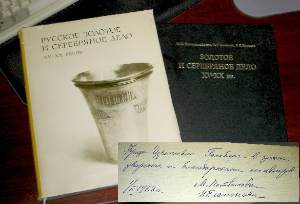
|
For those who want to learn more about the
sophisticated marks and the cooperation between
Russian companies I recommend a marvelous reference
book "Gold and silver work in 15th - 20th centuries",
edited by M. M. Postnikova-Loseva, published in
1983. This book remains the best catalog for Russian
and Soviet gold and silver. Unfortunately it has not
been translated into European languages. This
catalog is based on the book "Russian gold and
silver work in 15th to 20th centuries" written by
the same authors. First published in 1967, it soon
became a bibliographical rarity. The latter book
copy is in my library; it has the autographs of the
authors and was a gift to the editor.
|
Sometimes however even this comprehensive
catalog does not help. About three and a half years
ago I bought a large set of Russian silver on eBay.
The set of 64 pieces is great, but there is
something of additional value. The set came with a
57x45x22 cm large solid oak box. There are three
levels of shelves inside the box, and at each side
of it metal handles are provided for carrying or
transportation. When I unpacked the purchase, the
big box impressed me not less than its content. It
was made especially for the set which had originally
served 12 persons and had consisted of about 130
pieces (I bought only what was left of that). A
similar rarity I saw only once in my lifetime - in
the "Museum for Public Catering" in Moscow, Russia.
That museum had been opened in a former casino
located in an old quiet side street and vanished
pretty soon. Among the exhibits there were trunks
used for transportation of dishes to picnics. The
set that I have was made at the beginning of the
20th century. It is in excellent condition and looks
like new. Each piece has a legible mark
 (GL), but I failed to find any clue in any of the
catalogs. I found references to similar marks, but
both had been used in earlier times. One mark
belonged to a master from Irkutsk, Siberia, from the
years 1820 or so, the other one identifies with
Gregory Lakomkin, a 1st guild merchant from Moscow
who was known between the years 1736 and 1769. I
never found out by whom and where my set was made,
nevertheless this does not diminish its beauty and
its exclusivity.
(GL), but I failed to find any clue in any of the
catalogs. I found references to similar marks, but
both had been used in earlier times. One mark
belonged to a master from Irkutsk, Siberia, from the
years 1820 or so, the other one identifies with
Gregory Lakomkin, a 1st guild merchant from Moscow
who was known between the years 1736 and 1769. I
never found out by whom and where my set was made,
nevertheless this does not diminish its beauty and
its exclusivity.
|
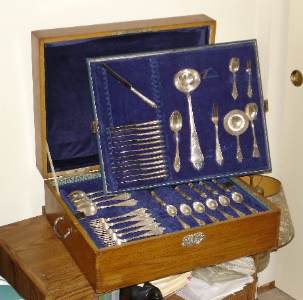 |
In the recent years my "hunting" became more specific. I get
more and more attracted to silver collectibles with views of
Moscow, the capital of Russia. Most of my life is connected with
this city; my close friends still live there, the city and its
quiet corners continue to move me even while I am far away.
Little by little, I acquired nielloed tea-glass holders with the
Kremlin and other views of Moscow landmarks. The niello
technique was particularly popular in Northern Russia. In my
collection I have by now glass holders from Kubachi (Southern
Russia), various cigarette cases - punched, engraved, embossed and
nielloed. The depicted views vary as well - the Kremlin Quay,
the Pashkov's House, even Lenin's first wooden mausoleum
erected in 1924 on the Red Square, which only existed 5 years.
I own a very old snuff box with a view of the Red Gate
remembered now only by Russians fond of the "good old times". The
spoons with Moscow views feature especially fine artwork.
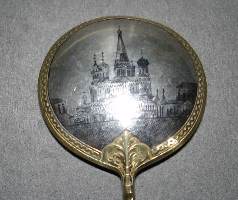
|
At one of the garage sales I saw a small set of
an American's souvenir spoons. I saw a jam spoon in
the set and its twisted handle looked typically Russian to me.
I found on the back of the spoon a detailed image of the
Cathedral of the Intercession of the Virgin (Pokrovsky)
in Red Square. A ring framing the image was decorated with a
geometrical pattern. This cathedral is more widely known by its
folk name of the Cathedral of St. Basil the Blessed (Vasily Blazhenny).
The contours look perfect even
through a magnifier. The earlier mentioned catalog
helped me to identify the origin. The spoon had been
made in 1880, in Moscow, in the workshop of Vasily
Osetrov. The collectibles of this kind have become a
material incarnation of my never ending bond with
Moscow: they make me feel the warmth of long gone
past, touch some deepest strings in my soul.
|
Samovars take a special place in each
collection. Their shapes vary surprisingly. A
samovar was made not by one but by many workers.
Each one usually worked at home and accomplished one
step or made parts of the same kind. A worker earned
roughly one ruble a day. The worth of finished
samovars was estimated by weight in poods (one pood
= 16 kilogram). They were sold by weight at wholesale
price. A dozen samovars packed in special containers
weighed more than four poods and cost approximately
90 rubles.
Samovar radiates a cozy family atmosphere, reminds
of a warm summer night in the country, of the
expressive painting "Tea-drinking in Mytischi" by
Kustodiev, the famous Russian artist. My memory
still recalls loads and loads of damaged samovars at
the stations for scrap metal, as well as those
crowded on the floor of the second hand shop in
October Square in Moscow. They no longer attracted
anyone except foreign tourists.
I got interested in samovars in America (apparently
out of nostalgia). I bought a few pieces on eBay. In
a Salvation Army Thrift Shop I saw a samovar burnt
to holes and with a 2 cm deep scale crust inside. To
the jealousy of my guests I made a desk lamp from
that with my own hands.
|
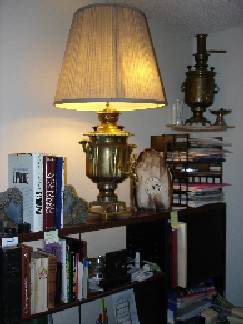 |
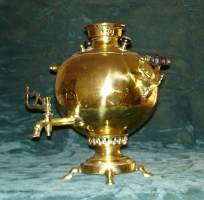
|
Not too long ago I visited an Estate sale in
a bohemian house from the thirties on Sunset
Boulevard in Los Angeles. A famous company rented
that estate for an antique show. I bought a round
shaped samovar for $50 there. It was polished like a
mirror. The thing had weathered many years, but the
time has not left any marks. The owners must have
brewed their tea some other way and not used the
samovar. But the thorough polishing before the show
eradicated the oval manufacture mark for the most
part. I could read only a mysterious Russian
abbreviation
 (T.D.N.K.).
Until now I have not been able to solve the puzzle.
I searched on the Internet, asked many private
collectors, looked in my personal library, even
wrote a letter to the "Samovar Museum" of Tula,
Russia, and inquired of other museums exhibiting
samovars. The abbreviation might stand for (T.D.N.K.).
Until now I have not been able to solve the puzzle.
I searched on the Internet, asked many private
collectors, looked in my personal library, even
wrote a letter to the "Samovar Museum" of Tula,
Russia, and inquired of other museums exhibiting
samovars. The abbreviation might stand for
 (Warehouse of Nemirov-Kolodkin) established in 1902.
The House was primarily known for gold and silver
products of the highest quality, but....why not
think positive and assume that my samovar is one of
a kind and was made by the famous House?
(Warehouse of Nemirov-Kolodkin) established in 1902.
The House was primarily known for gold and silver
products of the highest quality, but....why not
think positive and assume that my samovar is one of
a kind and was made by the famous House?
|
Speaking of architecture and crafts I would
say I prefer the Art Nouveau style that survived through
only a few dozen years (even less in
Russia) and was swallowed up by Art Deco. Both
styles are traditionally called modern in Russia.
I adore the villas by Shechtel and Kekushev, two
Moscow architects of modern. I repeatedly enjoy
the villa in Los Angeles on the crossing of Rodeo
Drive and Santa Monica Boulevard. I get mesmerized
by holding Art Nouveau books, jewelry or small vases
in my hands. The abundant details and inexhaustible
fantasy of my favorite style reflects the continuous
search for beauty so distinct for human beings.
I was happy when I bought an 11 inch high metal
vase at a garage sale for only $3. All parts of the
vase were so typical for Art Nouveau that my first
guess was that the piece had been an accurate
replica. The inscription "S. De Jardin" did not say
much to me. I do not know whether my vase is
original or a reproduction, but I placed it on the
shelf above my desk next to my samovar lamp, and I
like looking at it.
|
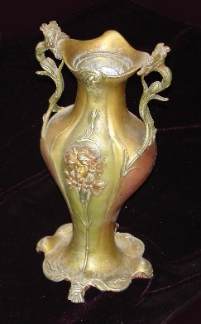 |
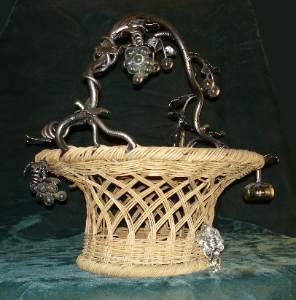
|
Of a similar elegance is the big basket from
my collection with its whimsical handle worked of a
solid twisted wire in the shape of a vine holding
leaves and grape bunches. It is a big basket, its
height exceeds 1 meter. I found the basket in a
Salvation Army boutique where prices are usually
low. Even empty, it seems to fill my room with
colorful fruits. I would like to ask my attentive
readers - perhaps, you might have seen a similar
beautiful thing and have a guess from where this
wonderful autumn miracle piece came.
|
There is an American saying: "You look like a million (dollars)!"
I do not claim that. But the never-ending joy from the rarities
I find and that fill my home is worth a million. I can consider
myself a millionaire, can't I? And a bunch of green bills or a
fat bank account - this is not my problem and not my destiny. I
probably could use my knowledge to sell my precious things and
make some extra money. But I'm afraid it would indeed make me
hopelessly poor. And I hope I'll be able to avoid such fate. If
my son or his children do not inherit my passion for "hunting"
and collecting, they will decide some day what to do with my
treasures. These will be different times, the times I won’t
belong to.
Today is the 1st of the month. I received my monthly Social
Security deposit. I am a Croesus! Why should I wish for more?
Lazar Freidgeim
- 2010 -
The author thanks Lydia Aleksev for her help in the writing of this work and additional
clarification of some of the material
|
 |
ABOUT THE AUTHOR
Lazar Freidgeim, engineer, research fellow. He was
born in Moscow, the capital of Russia, and has lived
there most of his life. Since 1991 he lives in
California (USA). In 2003 - retired - he began to
publish his articles and essays in magazines,
newspapers and online. His hobby is collecting old
Sterling silver, mainly from Russia. His main
interest is silver with images of architectural
monuments of Moscow.
|
|
|
 ASSOCIATION OF SMALL COLLECTORS OF ANTIQUE SILVER
ASSOCIATION OF SMALL COLLECTORS OF ANTIQUE SILVER ASSOCIATION OF SMALL COLLECTORS OF ANTIQUE SILVER
ASSOCIATION OF SMALL COLLECTORS OF ANTIQUE SILVER